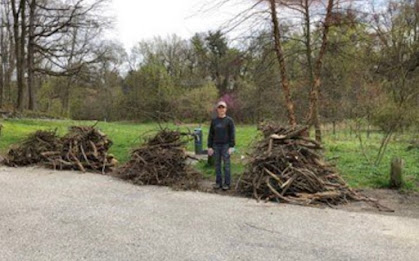Recently, the Penn State Extension Master Watershed Steward Program presented Search for Excellence Awards to acknowledge outstanding projects across the state in 2021 in three categories: Innovation, Restoration, and Educational Programming.
Innovation
York County’s Street2Creek Program won the Innovation category. The Street2Creek project uses artwork around drains to raise citizen awareness about the connection between storm drains and area streams.
Selected local artists are invited to paint small-scale murals around storm drains. The art must have a clear environmental message related to storm drains, pollution, or water quality.
The committee uses an annual art contest to choose the artists. Artists submit their sketches through the website, Street2Creek.org. A panel of community leaders and local artists review the art submissions and select the winning artists.
The Street 2 Creek committee holds the contest in May and the artists paint their murals during the summer. The project culminates in September with a presentation at YorkFest, an annual weekend-long fine arts festival.
Festival attendees receive a brochure outlining a self-guided walking tour of the painted drains. The drains form a path leading from Codorus Creek, source of the water used by City of York residents, to the Royal Square, an arts and shopping area in the city.
Restoration
The Restoration project award winner was Montgomery county's restoration of and improvement of the Rock Creek riparian buffer in Curtis Arboretum. (See photo.)
When the Curtis property was gifted to Cheltenham Township many years ago, the "arboretum" became a public park. Due to lack of funds and community interest, the riparian buffer and creek areas were badly neglected for decades.
Invasive plant species took over, the trees were strangled and, in many cases, they were killed and the creek banks lost most of their riparian vegetation.
Starting three years ago, MWSs have removed massive amounts of porcelain berry, bittersweet, multiflora roses, garlic mustard, and other invasives.
They engaged in a systematic cutting and treatment program of the Japanese knotweed, and removed vines from strangling 154 trees and shrubs.
They have planted more than 90 new native trees, 48 new shrubs, and more than 600 ferns.
In the spring of 2021, they installed 285 live stakes along the stream banks in some high erosion areas.
They have also led volunteer groups from Cheltenham High School and nearby Arcadia University, using their assistance for clean-ups and invasive removal.
Educational Programming
Monroe County's outreach program for Homeowners Associations won the final educational program category.
This group of Master Watershed Stewards observed that many Poconos residents live in Homeowners Associations (HOAs), many of which are centered around an inland lake and often have streams passing through their property.
For most, this is also their first experience with utilizing drinking water wells and septic systems.
Their HOA Community Outreach Program brings customized, focused, and interactive educational support and hands-on resources to the residents of Homeowners Associations. Presentations are tailored to the unique needs of a given HOA; prefaced by a site visit by Stewards to assess the primary watershed-related concerns and human impacts to water quality.
The process starts with a preliminary meeting with those in leadership at an HOA, such as Board Members or special Committee members, to learn their known environmental issues on the grounds, waterways, and/or in their surrounding watershed.
Next, they conduct an on-site visual tour of the HOA grounds with members in leadership roles of the HOA to fully understand proposed issues, possibly identify additional issues of importance, and offer basic advice on ways to handle the issues, including how the Stewards can assist further.
The goal is to present an educational seminar directly to the HOA residents.
Stewards create and provide a customized presentation educating Homeowner Associations on the basics of interacting with their watersheds in healthy ways; addressing their unique focus issues of concern and potential solutions, including background understanding of general watershed stewardship, and overview of the Master Watershed Steward Program and resources.
Their presentations are interactive whether in-person or virtual. They send attendees home with educational resources to learn more, and follow up with HOA leadership to assess how we can be of further assistance, such as co-creating a plan to address issues, and directing them to the best available research and guidance, including Penn State Extension resources and experts.
For more information on how you can get involved in your county, visit the Penn State Extension’s Master Watershed Steward Program webpage.
(Photo: Volunteer, Chrissa Pedersen, stands by three piles of vines, that were cut and removed on one day. Since the project began, the township has removed more than75 such piles of vine and invasive debris, all of which were choking the surviving trees.)
(Reprinted from Penn State Extension Watershed Winds newsletter. Click Here to sign up for your own copy.)
Related Articles This Week:
-- Penn State Extension Beings 5-Part Backyard Stream Repair Webinar Series March 15
-- Spotlight On A Busy Master Watershed Steward - Tom Price, Bucks County
-- Penn State Extension Drinking Water Team To Offer Water Testing In 18 PA Counties
Related Articles - Penn State Extension:
-- Penn State Extension 9-Part Webinar Series - Woods In Your Backyard [Now Going On]
-- Registration Now Open! Virtual 2022 Watershed Forestry Summit March 2-3
-- Penn State Extension 5-Part Webinar Series On Woodland Stewardship Starting March 2
-- Penn State/DCNR Forest Health, Insect And Disease Virtual Update March 17
-- Penn State Extension: Teach For Forests: Forest Education For Teachers, Youth Leaders
[Posted: February 22, 2022] PA Environment Digest


No comments :
Post a Comment